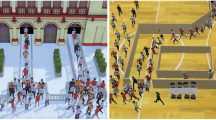Abstract
This paper presents a novel approach for individual agent’s motion simulation in real-time virtual environments. In our model, we focus on addressing two problems: 1) the control model for local motions. We propose to represent a combination of psychological and geometrical rules with a social and physical forces model so that it can avoid individual agent’s local collision. 2) Global path planning algorithm with moving obstacle. We propose a more efficient algorithm by extending the indicative route method. Experimental results show that the proposed approach can be tuned to simulate different types of crowd behaviors under a variety of conditions, and can naturally exhibit emergent phenomena that have been observed in real crowds.













Similar content being viewed by others
References
Adrien T, Seth C, Zoran P (2006) Continuum crowds. ACM Trans Graph 25(3):1160–1168
Chenney S (2004) Flow tiles. ACM SIGGRAPH/Eurographics Proceedings of Symposium on Computer Animation, pp 233–242
Chin CL, Huang Z, Liew PS (2009) Development of a computational cognitive architecture for intelligent virtual character. Conference on Computer Animation and Social Agents (CASA) (Amsterdam, Netherlands). Computer Animation and Virtual Worlds 20:257–266
Durupinar F, Allbeck J, Pelechano N, Badler NI (2008) Creating crowd variation with the OCEAN personality model. Proc of 7th Int Conf on Autonomous Agents and Multiagent Systems (AAMAS 2008), pp 1217–1220
Helbing D, Buzna L, Johansson A, Werner T (2005) Self-organized pedestrian crowd dynamics: experiments, simulations, and design solutions. Transp Sci 39(1):1–24
Helbing D, Farkas I, Vicsek T (2000) Simulating dynamical features of escape panic. Nature 407:487–490
Jin X, Xu J, Wang CCL, Huang S, Zhang J (2008) Interactive control of large-crowd navigation in virtual environments using vector fields. IEEE Comput Graph Appl 28(6):37–46
Karamouzas I, Overmars MH (2008) Adding variation to path planning. Computer animation and virtual worlds, pp 283–293
Karamouzas I, Roland G, Overmars MH (2009) Indicative routes for path planning and crowd simulation. The Fourth International Conference on the Foundations of Digital Games (FDG), pp 113–120.
Kirchner A, Nishinari K, Schadschneider A (2003) Friction effects and clogging in a cellular automaton model for pedestrian dynamics. Phys Rev E 67:51–60
Lokoba T, Kaup D, Finkelstein N (2005) Modification of the helbing molnar farkas vicsek social force model for pedestrian evolution. Simulation 81(5):339–352
Loscos C, Marchal D, Meyer A (2003) Intuitive crowd behavior in dense urban environments using local laws. In: Theory and Practice of Computer Graphics, IEEE, pp 122–129
Massive Software (2006) http://www.massivesoftware.com
Narain R, Golas A, Curtis S, Lin MC (2009) Aggregate dynamics for dense crowd simulation. ACM Transactions on Graphics. Proc. of ACM/SIGGRAPH Asia
Patil S, J van den Berg, Curtis S, Lin MC, Manocha D (2010) Directing crowd simulations using navigation fields. IEEE Transactions on Visualization and Computer Graphics, 09 Feb. 2010
Pelechano N, Allbeck JM, Badler NI (2007) Controlling individual agents in high-density crowd simulation. Eurographics/ACM SIGGRAPH Symposium on Computer Animation, August 02–04, 2007, San Diego, California
Pelechano N, Stocker C, Allbeck J, Badler NI (2008) Being a part of the crowd: towards validating VR crowds using presence. Proc of 7th Int Conf on Autonomous Agents and Multiagent Systems (AAMAS 2008), pp 136–142
Reynolds CW (1987) Flocks, herds, and schools: a distributed behavioral model. Computer Graphics (ACM SIGGRAPH ’87 Conference Proceedings), Anaheim, CA, USA, 21: 25–34
Reynolds CW (1999) Steering behaviors for autonomous characters. Proceedings of Game Developers Conference, pp. 763–782
Roland G, Overmars MH (2008) Enhancing corridor maps for real-time path planning in virtual environments. Computer Animation and Social Agents. In Computer Animation and Social Agents (CASA), pp 64–71
Shao W, Terzopoulos D (2007) Autonomous pedestrians. ScienceDirect 69:246–274
Tecchia F, Losocos C, Conroy R, Chrysanthou Y (2001) Agent behavior simulator(ABS):a platform for urban behavior development. Proceedings of ACM/EG Games Technology Conference. 2001
Acknowledgment
The authors would like to thank the anonymous reviewers for their helpful comments. We would like to thank Prof Ming-ting Sun for improving the writing of the paper. This work is partly supported by National High-Tech Program 863 of China (Grant No. 2007AA01Z322) and National Arm Research Program of China (Grant No.9140A06060208DZ0207).
Author information
Authors and Affiliations
Corresponding author
Rights and permissions
About this article
Cite this article
Rao, Y., Chen, L., Liu, Q. et al. Real-time control of individual agents for crowd simulation. Multimed Tools Appl 54, 397–414 (2011). https://doi.org/10.1007/s11042-010-0542-y
Published:
Issue Date:
DOI: https://doi.org/10.1007/s11042-010-0542-y




